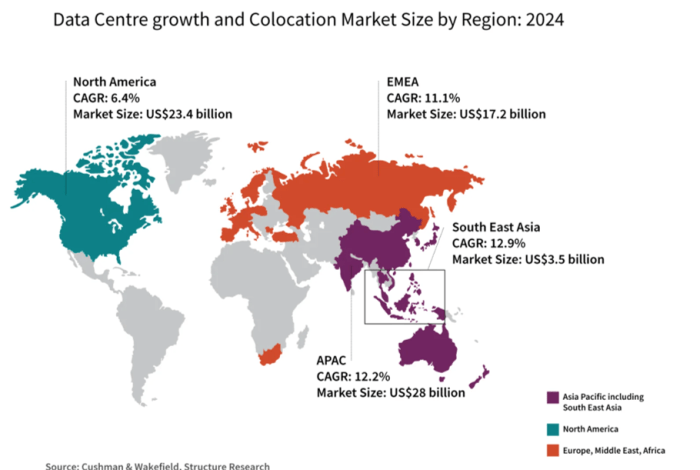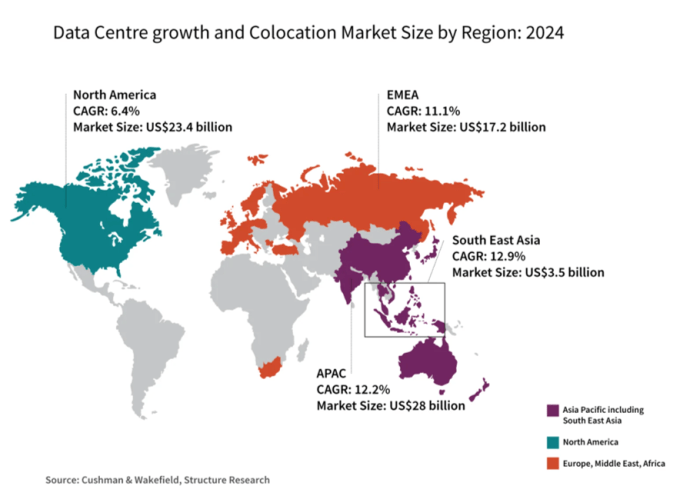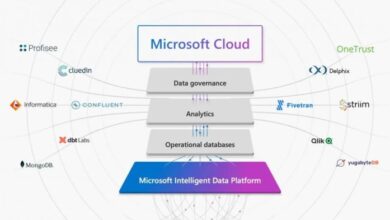
Data Centres Market Asia Pacific: A Booming Landscape
Data centres market Asia Pacific is experiencing explosive growth, fueled by the increasing demand for digital services and the region’s rapid technological advancements. From cloud computing to edge computing and 5G, Asia Pacific is at the forefront of innovation, driving the need for robust and scalable data center infrastructure.
The region is witnessing a surge in investments, with major players vying for market share in this lucrative sector.
The data center market in Asia Pacific is a dynamic and complex ecosystem, with diverse players operating across various segments. Understanding the key drivers, challenges, and trends shaping this market is crucial for businesses looking to capitalize on the opportunities it presents.
Market Overview: Data Centres Market Asia Pacific

The Asia Pacific data center market is experiencing robust growth, driven by increasing digitalization, cloud adoption, and the rise of big data and artificial intelligence. The region is home to some of the world’s fastest-growing economies, with a burgeoning middle class and a rapidly expanding digital footprint.
Market Size and Growth Rate
The Asia Pacific data center market is projected to reach a value of \$100 billion by 2025, growing at a CAGR of over 10%. This growth is fueled by several factors, including:
- Increasing digitalization across various industries, including finance, healthcare, and retail, is driving the need for robust IT infrastructure, including data centers.
- Cloud computing adoption is rapidly expanding in the region, with businesses migrating their workloads to the cloud, creating a surge in demand for data center capacity.
- The emergence of big data and artificial intelligence (AI) applications requires significant data processing and storage capabilities, further driving data center investments.
Key Drivers and Challenges
Several key drivers are propelling the growth of the Asia Pacific data center market, while some challenges remain:
Key Drivers
- Government Initiatives:Governments across the region are promoting digitalization and supporting the development of data centers to boost economic growth and create new job opportunities. For instance, Singapore has implemented a national digital strategy that aims to make the country a leading digital economy, encouraging investment in data centers.
- Favorable Regulatory Environment:Many countries in Asia Pacific have adopted supportive regulations for data center development, including streamlined permitting processes and tax incentives. This makes the region an attractive destination for data center operators.
- Strong Economic Growth:The region’s robust economic growth is driving investment in data centers, as businesses expand their operations and invest in new technologies.
- Rising Internet and Mobile Penetration:The increasing penetration of internet and mobile devices in Asia Pacific is creating a surge in data traffic, requiring increased data center capacity to support the growing demand.
Challenges
- High Energy Costs:The high cost of energy in some parts of Asia Pacific can pose a significant challenge for data center operators, impacting operational costs and profitability.
- Land Scarcity:The availability of land for data center construction can be limited in some densely populated areas, leading to higher land costs and potentially delaying project development.
- Cybersecurity Concerns:With the increasing reliance on data centers, cybersecurity concerns are becoming more prominent. Data center operators need to invest in robust security measures to protect sensitive data from cyberattacks.
Comparison to Other Regions, Data centres market asia pacific
The Asia Pacific data center market is growing at a faster pace than other regions, including North America and Europe. This is attributed to the region’s high growth potential, increasing digitalization, and supportive government policies. However, the region also faces unique challenges, such as high energy costs and land scarcity.
Competitive Landscape
The Asia Pacific data center market is highly competitive, with a diverse range of players, including global giants, regional players, and local providers. Some of the key players in the market include:
- Equinix:A global leader in data center services, Equinix has a strong presence in Asia Pacific, operating multiple data centers across key markets, including Singapore, Hong Kong, and Japan.
- Digital Realty:Another major player in the global data center market, Digital Realty operates data centers in several Asian countries, including China, India, and Australia.
- Global Switch:A leading European data center provider, Global Switch has expanded its operations into Asia Pacific, with data centers in Singapore and Hong Kong.
- China Telecom:As one of the largest telecommunications providers in China, China Telecom operates a significant number of data centers in the country, catering to both domestic and international clients.
- Singtel:A leading telecommunications company in Singapore, Singtel has invested heavily in data center infrastructure, providing services to businesses across the region.
Market Share
The market share is constantly evolving, but these players hold a significant share of the market, competing on factors such as price, service quality, and geographic reach. The competitive landscape is expected to remain intense as new players enter the market and existing players expand their operations.
The data centres market in Asia Pacific is booming, driven by the region’s rapid digital transformation and growing demand for cloud computing. While navigating this complex landscape, sometimes you just need a sweet escape, like a visit to the red velvet sweet shoppe , a delightful haven for dessert lovers.
Back to the data centres, the region’s robust infrastructure investments and increasing adoption of advanced technologies like artificial intelligence and the Internet of Things are fueling the market’s growth, making it a prime location for data centre operators and businesses alike.
Infrastructure & Technology
The data center infrastructure in Asia Pacific is rapidly evolving, driven by the increasing demand for digital services and the adoption of new technologies. This section delves into the types of data center infrastructure prevalent in the region, explores the adoption of emerging technologies, discusses the role of green data centers, and analyzes the impact of government policies and regulations on data center development.
Types of Data Center Infrastructure
The data center infrastructure in Asia Pacific encompasses a wide range of facilities, from traditional on-premises data centers to cloud-based and edge computing solutions.
- Traditional On-Premise Data Centers: These are physical data centers owned and operated by organizations, typically located in large metropolitan areas. They offer high levels of security and control but can be expensive to build and maintain.
- Colocation Data Centers: These facilities provide space, power, and cooling to organizations that want to house their servers and equipment in a secure and reliable environment. Colocation data centers offer flexibility and cost-effectiveness compared to traditional on-premises data centers.
- Hyperscale Data Centers: These are massive data centers owned and operated by large cloud providers like Amazon Web Services (AWS), Microsoft Azure, and Google Cloud Platform. They offer a wide range of services and resources, including compute, storage, networking, and databases.
- Edge Data Centers: These are smaller data centers located closer to users, typically in urban areas or at the edge of the network. They are designed to reduce latency and improve performance for applications that require low latency, such as gaming, streaming, and IoT.
Adoption of Emerging Technologies
The adoption of emerging technologies, such as cloud computing, edge computing, and 5G, is driving significant changes in the data center landscape in Asia Pacific.
- Cloud Computing: Cloud computing has become increasingly popular in Asia Pacific, with organizations migrating their workloads to the cloud to gain access to scalability, flexibility, and cost savings. The region is home to several major cloud providers, including AWS, Azure, and Alibaba Cloud, which are investing heavily in data center infrastructure to meet the growing demand.
- Edge Computing: Edge computing is gaining traction in Asia Pacific as organizations look to reduce latency and improve performance for applications that require real-time data processing. Edge data centers are being deployed in various industries, including retail, manufacturing, and healthcare, to support applications like IoT, AI, and machine learning.
The data centres market in Asia Pacific is booming, driven by the region’s rapidly growing digital economy. This growth is fueled by factors like increasing internet penetration, cloud computing adoption, and the rise of e-commerce. While data centres are crucial for this digital transformation, the need for sustainable and reliable energy sources remains a key concern.
This is where news like VR Resources expanding its Empire property and reporting copper, gold, and PGE mineralization becomes significant. These discoveries could potentially contribute to the development of new energy solutions for data centres in the region, ensuring a sustainable future for the digital economy.
- 5G: The rollout of 5G networks in Asia Pacific is expected to further accelerate the adoption of cloud and edge computing. 5G’s high bandwidth and low latency will enable new data-intensive applications and services, creating a demand for more data center capacity.
Green Data Centers and Sustainable Practices
The growing environmental impact of data centers has led to a focus on green data centers and sustainable practices in Asia Pacific.
- Energy Efficiency: Data centers are energy-intensive facilities, and reducing their energy consumption is a key priority. Green data centers are designed with energy efficiency in mind, using technologies like energy-efficient servers, power management systems, and cooling solutions.
- Renewable Energy: Many data center operators are adopting renewable energy sources, such as solar and wind power, to reduce their carbon footprint.
Some data centers are even powered entirely by renewable energy.
- Waste Reduction: Data centers are also taking steps to reduce waste, including recycling and reuse of equipment.
Impact of Government Policies and Regulations
Government policies and regulations are playing a crucial role in shaping the data center landscape in Asia Pacific.
- Data Localization Policies: Many countries in the region have implemented data localization policies that require organizations to store data within their borders. These policies can create challenges for data center operators but also provide opportunities for growth.
- Cybersecurity Regulations: Governments are also introducing cybersecurity regulations to protect data and critical infrastructure.
Data center operators need to comply with these regulations to ensure the security of their facilities.
- Incentives for Green Data Centers: Some governments are offering incentives to encourage the development of green data centers. These incentives can include tax breaks, subsidies, and grants.
Key Market Segments
The Asia Pacific data center market is segmented based on the type of service offered, including colocation, cloud, and enterprise data centers. Each segment caters to different needs and trends, contributing to the overall market growth in unique ways.
Colocation Data Centers
Colocation data centers provide physical space and infrastructure for businesses to house their servers and other IT equipment. This segment is driven by the increasing demand for secure and reliable data storage and processing capabilities, particularly among enterprises seeking to expand their operations in the region.
Colocation data centers offer several advantages, including:
- Scalability:Businesses can easily scale their IT infrastructure up or down as needed, providing flexibility and cost-effectiveness.
- Security:Colocation facilities offer advanced security measures, including physical access control, surveillance systems, and disaster recovery plans, ensuring data protection and business continuity.
- Cost-effectiveness:Businesses can avoid the upfront investment and ongoing maintenance costs associated with building and managing their own data centers.
The colocation segment is expected to grow significantly in the coming years, driven by the increasing adoption of cloud computing and the rise of digital businesses in the region. For instance, the adoption of 5G technology is expected to drive the need for high-capacity data centers, which will further fuel the growth of the colocation segment.
Cloud Data Centers
Cloud data centers provide on-demand access to computing resources, storage, and other services over the internet. This segment is witnessing rapid growth due to the increasing adoption of cloud computing by businesses of all sizes. Cloud data centers offer several advantages, including:
- Flexibility:Businesses can access and scale computing resources as needed, eliminating the need for upfront investments in hardware and infrastructure.
- Cost-efficiency:Cloud computing allows businesses to pay only for the resources they use, reducing operational costs and improving efficiency.
- Innovation:Cloud platforms provide access to advanced technologies and services, enabling businesses to innovate and develop new solutions quickly.
The cloud data center segment is expected to grow at a rapid pace in the coming years, driven by the increasing adoption of cloud services, such as Software as a Service (SaaS), Infrastructure as a Service (IaaS), and Platform as a Service (PaaS).
The data centres market in Asia Pacific is booming, driven by the increasing adoption of cloud computing and digital transformation initiatives. While I’m busy analyzing market trends, I’m also craving a sweet treat – a halfway homemade buttermilk honey pie sounds perfect! After all, a little indulgence helps keep the mind sharp, especially when you’re navigating the complex landscape of the data centre market in Asia Pacific.
The region is witnessing a surge in the adoption of cloud services by enterprises across various industries, including finance, healthcare, and retail, further driving the growth of the cloud data center segment.
Enterprise Data Centers
Enterprise data centers are owned and operated by individual businesses to manage their critical IT infrastructure and data. This segment is characterized by the need for high levels of security, reliability, and performance to support core business operations. Enterprise data centers are typically customized to meet the specific needs of the business, offering greater control over data and infrastructure.
- Security:Enterprise data centers are designed with robust security measures to protect sensitive data and critical IT infrastructure.
- Performance:Enterprise data centers prioritize high performance to ensure seamless business operations and minimize downtime.
- Control:Businesses have complete control over their data and infrastructure, allowing them to tailor their environment to meet specific needs.
The enterprise data center segment is expected to experience steady growth, driven by the increasing need for data security and compliance, as well as the growing adoption of advanced technologies, such as artificial intelligence (AI) and machine learning (ML). The demand for enterprise data centers is particularly high in industries with stringent regulatory requirements, such as finance and healthcare.
Regional Trends & Opportunities
The Asia Pacific data center market is characterized by diverse growth patterns and unique opportunities across different regions. Understanding these regional trends is crucial for businesses seeking to invest in or expand their data center operations within the region.
Growth Drivers and Promising Markets
The Asia Pacific data center market is experiencing robust growth driven by several factors, including the increasing adoption of cloud computing, the proliferation of mobile devices, and the rise of e-commerce and digital services.
- China: As the world’s second-largest economy, China is a leading driver of data center growth in the region. The country’s booming digital economy, fueled by e-commerce giants like Alibaba and Tencent, has created a massive demand for data center infrastructure.
The Chinese government’s initiatives to promote digitalization and cloud adoption further accelerate this growth.
- India: India is another key market with significant growth potential. The country’s rapidly expanding digital economy, driven by factors such as increasing smartphone penetration and government initiatives like Digital India, is driving the demand for data centers.
- Singapore: Singapore is a leading data center hub in Southeast Asia, attracting investments from global players due to its stable political environment, robust infrastructure, and pro-business policies.
- Australia: Australia’s data center market is driven by factors such as the increasing adoption of cloud computing, the growth of the financial services sector, and the government’s focus on cybersecurity.
Investment Opportunities and Expansion Strategies
The Asia Pacific data center market offers attractive investment opportunities for businesses looking to capitalize on the region’s rapid growth.
- Colocation Data Centers: The demand for colocation services is growing rapidly in the region as businesses seek to outsource their IT infrastructure needs.
- Hyperscale Data Centers: Hyperscale data centers are essential for supporting the growing demand for cloud services and big data analytics. The region is witnessing significant investments in hyperscale data centers by global cloud providers such as Amazon Web Services (AWS), Microsoft Azure, and Google Cloud.
- Edge Data Centers: Edge data centers are becoming increasingly important as businesses seek to reduce latency and improve performance for their applications. The rise of 5G and the Internet of Things (IoT) is further driving the demand for edge data centers.
Impact of Emerging Technologies
Emerging technologies are transforming the Asia Pacific data center market.
- Artificial Intelligence (AI): AI is driving the demand for high-performance computing (HPC) and data storage capabilities, creating opportunities for data centers with advanced infrastructure.
- Internet of Things (IoT): The rapid growth of IoT devices is generating massive amounts of data, driving the demand for data centers with high bandwidth and low latency.
- Blockchain: Blockchain technology is creating opportunities for data centers with specialized infrastructure and security capabilities.
Regional Variations and Key Considerations
While the Asia Pacific data center market is experiencing overall growth, there are significant regional variations.
- Regulatory Landscape: Different countries in the region have varying regulatory frameworks for data centers, including data privacy laws and cybersecurity regulations.
- Infrastructure Availability: The availability of power, fiber optic connectivity, and skilled labor varies across the region.
- Market Competition: Competition in the data center market is intensifying, with global players entering the region and local providers expanding their operations.
Future Outlook
The data center market in Asia Pacific is poised for continued growth, driven by factors such as the increasing adoption of cloud computing, the rise of digitalization, and the growing demand for data storage and processing. This section delves into the future trajectory of the market, analyzing key trends and factors, identifying emerging opportunities and challenges, and providing insights into the future of data center technology and innovation in the region.
Projected Growth Trajectory
The Asia Pacific data center market is projected to experience significant growth in the coming years. According to a report by MarketsandMarkets, the market is expected to reach USD 143.5 billion by 2027, growing at a CAGR of 14.5% during the forecast period.
This growth is driven by several factors, including:
- Rising Cloud Adoption:Cloud computing services, such as Infrastructure-as-a-Service (IaaS), Platform-as-a-Service (PaaS), and Software-as-a-Service (SaaS), are becoming increasingly popular in Asia Pacific. This trend is driving the demand for data center capacity to support cloud infrastructure.
- Digital Transformation:Businesses across various sectors are embracing digital transformation initiatives, which require robust data center infrastructure to support their digital operations. This includes the adoption of artificial intelligence (AI), big data analytics, and the Internet of Things (IoT).
- Growing Data Volumes:The exponential growth in data volumes generated by businesses and consumers is driving the need for more data storage and processing capacity. This is particularly evident in industries such as e-commerce, financial services, and healthcare.
- Government Initiatives:Governments in Asia Pacific are actively promoting digitalization and smart city initiatives, which require advanced data center infrastructure to support these projects.
Impact of Key Trends and Factors
Several key trends and factors will shape the future of the data center market in Asia Pacific, including:
- Edge Computing:Edge computing is gaining traction as businesses seek to reduce latency and improve data processing speeds. This trend is driving the demand for smaller, distributed data centers located closer to end users.
- Sustainability:Sustainability is becoming increasingly important for data center operators. This includes adopting energy-efficient technologies, reducing carbon emissions, and utilizing renewable energy sources.
- Cybersecurity:Cybersecurity is a major concern for businesses in Asia Pacific, as data breaches and cyberattacks become more frequent. This is driving the demand for advanced security measures and solutions within data centers.
- Artificial Intelligence (AI):AI is transforming various industries, driving the need for high-performance computing (HPC) and data analytics capabilities. This is creating new opportunities for data center providers to support AI workloads.
Emerging Opportunities and Challenges
The Asia Pacific data center market presents both opportunities and challenges for data center providers:
Opportunities
- Growing Demand for Colocation Services:Colocation services, which allow businesses to lease space and infrastructure within data centers, are becoming increasingly popular. This provides an opportunity for data center providers to expand their offerings and cater to a wider range of customers.
- Expansion into Emerging Markets:Emerging markets in Asia Pacific, such as Vietnam, Indonesia, and the Philippines, are experiencing rapid economic growth and digitalization. This presents opportunities for data center providers to establish a presence in these markets.
- Specialized Data Center Solutions:Data center providers can specialize in specific industries or sectors, such as healthcare, finance, or manufacturing. This allows them to develop niche expertise and cater to the unique needs of these industries.
Challenges
- Competition:The data center market in Asia Pacific is becoming increasingly competitive, with both local and global players vying for market share. This requires data center providers to differentiate themselves and offer competitive pricing and services.
- Regulatory Landscape:The regulatory landscape for data centers is evolving in Asia Pacific, with governments introducing new regulations to address data privacy and security concerns. Data center providers need to comply with these regulations to operate legally and avoid penalties.
- Talent Acquisition:The demand for skilled professionals in the data center industry is high, making it challenging to attract and retain talent. Data center providers need to invest in training and development programs to build a skilled workforce.
Future of Data Center Technology and Innovation
Data center technology is constantly evolving, with new innovations emerging to improve efficiency, performance, and security. Some key trends shaping the future of data center technology in Asia Pacific include:
- Hyperscale Data Centers:Hyperscale data centers are massive facilities designed to handle enormous data volumes and processing power. These facilities are becoming increasingly common in Asia Pacific as businesses adopt cloud computing and AI.
- Liquid Cooling:Liquid cooling is a more efficient and energy-saving method of cooling data center equipment compared to traditional air conditioning systems. This technology is gaining traction in Asia Pacific as data centers strive for greater sustainability.
- Software-Defined Networking (SDN):SDN allows for the automation and virtualization of network infrastructure, enabling data center operators to manage their networks more efficiently and dynamically. This technology is being adopted by data center providers in Asia Pacific to enhance flexibility and scalability.
- Edge Data Centers:Edge data centers are smaller, distributed facilities located closer to end users. This trend is driven by the need for low latency and faster data processing speeds. Edge data centers are expected to play a significant role in the future of the data center market in Asia Pacific.







